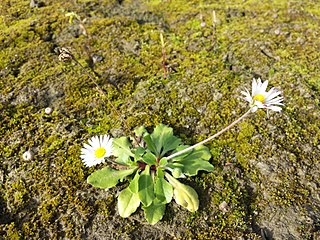
Bellis perennis, the daisy, is a European species of the family Asteraceae, often considered the archetypal species of the name daisy. To distinguish this species from other plants known as daisies, it is sometimes qualified or known as common daisy, lawn daisy or English daisy.

Campanula americana, the American bellflower, or tall bellflower, is a bellflower native to eastern North America. Tall bellflowers can be annual or biennial with a varying life-history with seeds germinating in the fall producing annual plants and spring-germinating seeds producing biennial plants. Long-tongued bees are the primary pollinators, including Megachile campanulae, but halictid bees, butterflies, and skippers may also act as pollinators. Tall Bellflowers do not generally self-pollinate. Some authorities, including the USDA PLANTS database, consider the name Campanulastrum americanum to be the accepted name for this species.

Indole-3-butyric acid (1H-indole-3-butanoic acid, IBA) is a white to light-yellow crystalline solid, with the molecular formula C12H13NO2. It melts at 125°C in atmospheric pressure and decomposes before boiling. IBA is a plant hormone in the auxin family and is an ingredient in many commercial horticultural plant rooting products.

Phu Kradueng National Park, in the Si Than sub-district of Amphoe Phu Kradueng, Loei Province, is one of the best known national parks of Thailand. It has a high point of 1,316 m (4318 ft) elevation at Khok Moei. It was proclaimed a national park on 23 November 1962, making it the second national park of Thailand after Khao Yai National Park.

Sonchus asper, the prickly sow-thistle, rough milk thistle, spiny sowthistle, sharp-fringed sow thistle, or spiny-leaved sow thistle, is a widespread flowering plant in the tribe Cichorieae within the family Asteraceae.
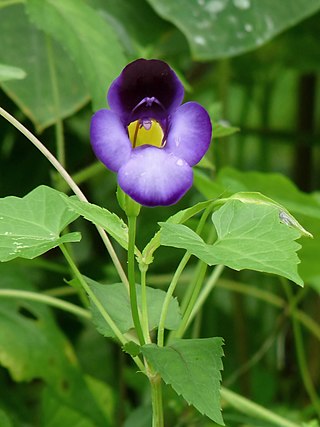
Torenia is a genus of plants now classified in the family Linderniaceae. Torenia has also been classified in the figwort family Scrophulariaceae. Often called wishbone flowers, bluewings; in Hawaii nanioola'a or ola'a beauty, some species are grown as garden plants. Many F1 and F2 Torenia hybrids have been hybridized in the last 30 years. Colors can range from white with yellow throats to violet, blue, cobalt, lavender and purple.

Triglochin maritima is a species of flowering plant in the arrowgrass family Juncaginaceae. It is found in brackish marshes, freshwater marshes, wet sandy beaches, fens, damp grassland and bogs. It has a circumboreal distribution, occurring throughout the northern Northern Hemisphere. In the British Isles it is common on the coast, but very rare inland.
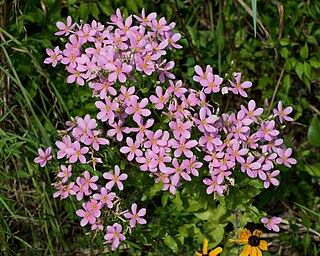
Sabatia, the rose gentians, is a genus of about 20 species of flowering plants in the family Gentianaceae, native to eastern and central North America, Central America, and the Caribbean.

Linderniaceae is a family of flowering plants in the order Lamiales, which consists of about 25 genera and 265 species occurring worldwide. Vandellia micrantha is eaten in Laos, but tastes bitter. Best known are the wishbone flowers Torenia fournieri and Torenia thouarsii, which are used as bedding plants, especially in the tropics. Micranthemum is sold as an aquarium plant when it is called 'baby tears'.

Amphicarpaea bracteata is an annual to perennial vine in the legume family, native to woodland, thickets, and moist slopes in eastern North America.

Tordylium apulum, commonly known as the Mediterranean hartwort, is an annual forb or herb. It is classified within the family Apiaceae, the carrot family. It is native to Europe and Western Asia, but has been introduced to the United States, where it is now found only in Arizona. This plant's seeds are suggested as the plant model used for the famous gold "Malia Pendant", a jewel of high quality gold-smithery of the Minoan times now on display at the Heraklion Archaeological Museum.

Mirabilis laevis, the desert wishbone-bush, is a recently redefined species of flowering plant in the four o'clock family. Distribution is in the Southwestern United States and northwest Mexico.
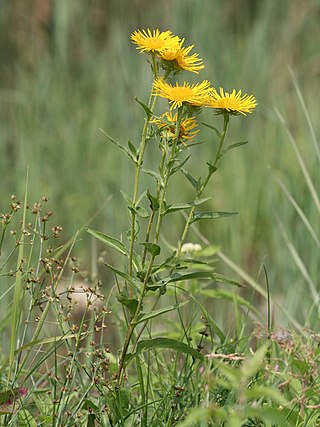
Pentanema britannica, the British yellowhead or meadow fleabane, is a Eurasian species of plant in the daisy family. It is widespread across much of Europe and Asia, and sparingly naturalized in scattered locations in North America.

Reseda odorata is a species of flowering plant in the reseda family known by many common names, including garden mignonette and common mignonette. It is probably native to the Mediterranean Basin, but it can sometimes be found growing in the wild as an introduced species in many parts of the world. These introductions are often garden escapees; the plant has long been kept as an ornamental plant for its fragrant flowers, the essential oil of which has been used in perfumes. This is an annual herb, producing branching erect stems to 80 centimeters in maximum height. The inflorescence is a spike-like raceme of many flowers. The fragrant flower has six white to yellowish or greenish petals, the upper ones each divided into three narrow, finger-like lobes. At the center of the flower are up to about 25 stamens tipped with large dangling orange anthers.

Sagina apetala is a species of flowering plant in the family Caryophyllaceae known by the common names annual pearlwort and dwarf pearlwort. It is native to Europe and it is known elsewhere as an introduced species, including parts of North America. It grows in many types of disturbed habitat, such as cracks in the sidewalk. It is a petite annual herb producing a threadlike stem just a few centimeters long, spreading or growing erect. The plant is glandular and somewhat hairy. The leaves are linear in shape and not more than about a centimeter long. The inflorescence is a solitary flower borne on a threadlike pedicel. The flower has usually four sepals and generally no petals.

Sisyrinchium dichotomum is a rare species of flowering plant in the iris family known by the common names wishbone blue-eyed grass, white irisette, and reflexed blue-eyed grass. It is native to North Carolina and South Carolina in the United States, where fewer than ten populations remain in four counties. It is threatened by the loss and degradation of its habitat and is a federally listed endangered species of the United States.

Suaeda maritima is a species of flowering plant in the family Amaranthaceae known by the common names herbaceous seepweed and annual seablite.
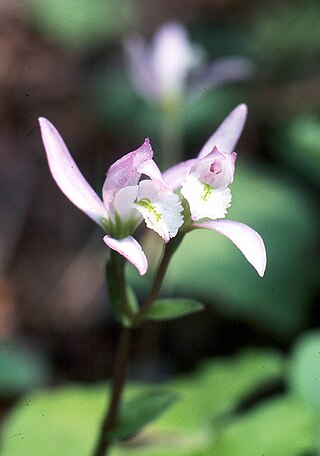
Triphora trianthophoros, the threebirds or three birds orchid, or nodding pogonia, is a species of terrestrial orchid native to eastern North America.

Hedypnois rhagadioloides, the Cretanweed or scaly hawkbit, is a species of plant in the tribe Cichorieae within the family Asteraceae. It is native to the Mediterranean Region and neighboring areas from Canary Islands to Iran, and naturalized in Australia and in parts of the Americas.

Torenia travancorica is a species of flowering plant belonging the family Linderniaceae. It is seen in evergreen forests and grasslands of the Western Ghats.






















